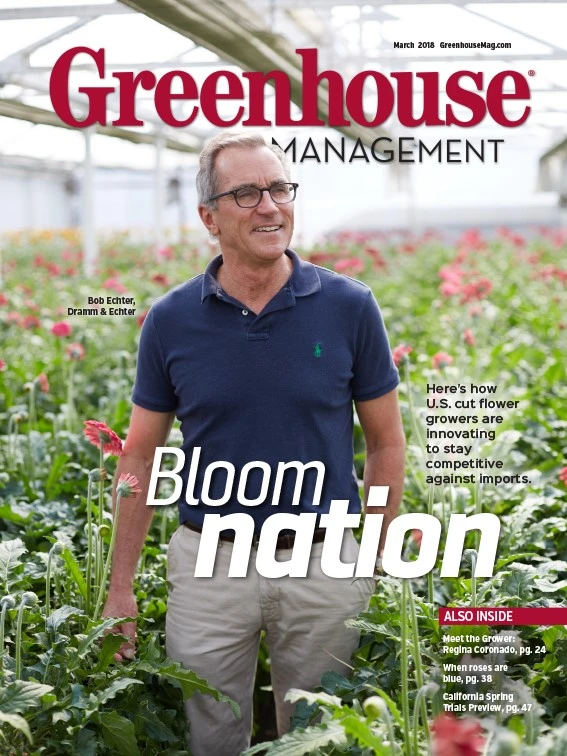


AROUND THE SHOW FLOOR
As usual, the exhibitors went the extra mile to create eye-catching, creative booth displays. Here are a few of the sights that stood out (clockwise from top): United Nursery's Candyland-themed booth; Penang Nursery went all in on an international travel theme; Live Trends gave a nod to the 2018 Pantone Color of the Year, Ultra Violet.
SHOWCASING PLANTS IN UNIQUE WAYS
It’s not always a matter of having the newest or the flashiest variety. Sometimes, it’s rethinking the way the plant is packaged. Here are three creative planters we saw at the show.
1. Kokodama. Sun Bulb Co. showed off its line of Kokodama, or “handmade spheres made from coco fibers,” planters, potted up with orchids, bromeliads and many other tropical plants. It’s a unique look that could work for a wide variety of plants.

2. Tropical Combo planters. Homestead Growers & Amerigo Farms teamed up to offer these seasonal three-plant combination planters in rustic-style wooden drawers. Each planter has a waterproof liner, a foam insert with spaces for the three plants and moss to cover the foam after placing the plants. At the end of the tropical plants’ life-cycle, consumers can “Twist and Trade” and swap out the plants for new ones.

3. “Jellyfish” tillandsias and sea-themed planters. This year, we saw a “wave” of sea-themed planters, including these from the Russell’s Bromeliads booth, made with sea urchins and shells.


The Garden Center Group once again held their TPIE Cool Products Awards contest. View the full list of the official Cool Products winners here.

5 TRENDS WORTH WATCHING
Max Luthy, director of trends and insights at TrendWatching, gave an energetic keynote on Wednesday morning. He showcased five trends that growers and retailers alike should keep in mind as they plan for the upcoming year. Spoiler alert: It wasn’t all about technology.
Ambient wellness. Although merely 3 percent of Americans meet the criteria for a healthy lifestyle, Luthy said that people still want to be surrounded by healthiness, whether that’s wearing activewear to run errands, or using copper-infused bedsheets. The question becomes how do we embed our own version of physical and mental wellness into our customers’ surroundings.
Inner journeys. There has been a shift toward ancient forms of self-discovery, Luthy says. That includes anything from learning the art of foraging to DNA testing to biodegradable urns that will grow trees. Modern consumers want to improve themselves and reduce their impact on the world by returning to their roots (sometimes literally).
Cultural creditors. We’re finding ourselves in an era of global monoculture, as a direct result of worldwide phenomena such as Pokémon, IKEA and Starbucks. However, at the same time, it’s also become unacceptable to inappropriately depict people from other cultures, such as by dressing up as them at Halloween. The challenge for growers and retailers is determining how to better credit, champion and celebrate the cultures your business and products draw from, without alienating or offending. Are you being respectful with that display with the Buddha statues? Are you marketing your Asian plant offerings appropriately?
Tribefacturing. Rather than marketing to specific demographics or cultures, Luthy suggests using this technique. When you use tribefacturing, you’re grouping people by values, interests and passions rather than beliefs or physical characteristics. Examples of these tribes include: yogis, animal lovers and “makers” or DIYers. Luthy gave the example of one garden center that offered a combination succulent planting and yoga class.
Automated commerce. In the past few years, we’ve seen a significant increase in digital tools that help us to automate and streamline processes in our lives. Devices will sense when we’re out of paper towels or milk and automatically reorder them, and others will help us to organize our closet or give real-time feedback on the outfit you’re wearing. “What do your customer interactions look like in the emerging era of automated commerce?” Luthy asked.

Explore the March 2018 Issue
Check out more from this issue and find your next story to read.
Latest from Greenhouse Management
- Super Charged Moon Juice from Moon Valley Nurseries now available nationally
- 2025 Proven Winners Horticulture Scholarship applications now open
- How to improve inventory and shipping management in the greenhouse
- Leading Women of Horticulture: Anna Ball, Ball Hort, and Terri McEnaney, Bailey Nurseries
- GM CEA HERB Part 2: A guide to increasing the sowing density of culinary herbs
- GM CEA HERB Part 1: Best practices for producing culinary herbs in controlled environments
- USDA fires experts on invasive pests, including Asian citrus psyllid, chilli thrips
- CEA Alliance celebrates bipartisan introduction of Supporting Innovation in Agriculture Act





